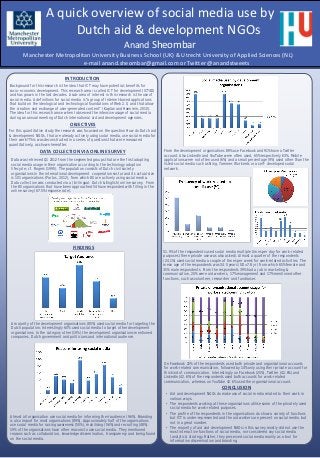
Poster Presentation Ecrea2012 Anand Sheombar
- 1. A quick overview of social media use by Dutch aid & development NGOs Anand Sheombar Manchester Metropolitan University Business School (UK) & Utrecht University of Applied Sciences (NL) e-mail anand.sheombar@gmail.com or Twitter @anandstweets INTRODUCTION Background for this research is the idea that ICT may have potential; benefits for socio-economic development. This research area is called ICT for development (ICT4D) and has grown in the last decades. A sub-area of interest in this research is the use of social media. A definitions for social media is "a group of Internet-based applications that build on the ideological and technological foundations of Web 2.0, and that allow the creation and exchange of user-generated content“ (Kaplan and Haenlein, 2010). The idea for this research arose when I observed the intensive usage of social media during an annual meeting of Dutch international aid and development agencies. OBJECTIVES For this quantitative study the research was focussed on the question How do Dutch aid & development NGOs, that are already actively using social media, use social media for their work? This was deconstructed in a series of questions that were measured quantitatively, as shown hereafter. DATA COLLECTION VIA ONLINE SURVEY From the development organisations 89% use Facebook and 91% have a Twitter account. Also LinkedIn and YouTube were often used, 65% respectively 63%. Mobile Data was retrieved Q1 2012 from the segmented groups that are the first adopting applications were not often used (6%) and a small percentage (9%) used other than the social media usage in their organisation according to the technology adoption listed social media such as Ning, Yammer, Worknets or a self- developed social lifecycle; cf. Rogers (1995). The population consists of Dutch civil society network. organisations in the international development cooperation sector and its actual size is 101 organisations (Partos, 2012), from which 80 are actively using social media. Data collection was conducted via a (bi-lingual: Dutch & English) online survey. From the 80 organisations that have been approached 54 have responded with filling in the online survey (67.5% response rate). FINDINGS 51.9% of the respondents used social media multiple times per day for work-related purposes (there private use was also asked). Almost a quarter of the respondents (24.1%) used social media a couple of times per week for work-related activities. The mean age of the respondents was 34.5 years (SD =7.8 yr) from which 65% female and 35% male respondents. From the respondents 39% had a job in marketing & communication, 20% were aid workers, 17% management and 17% mentioned other functions, such as volunteer, researcher and fundraiser. A majority of the development organisations (85%) used social media for targeting the Dutch population. Interestingly 60% used social media to target other development organisations. In the category other (19%) the development organisations mentioned companies, Dutch government and politicians and international audience. On Facebook 25% of the respondents used both private and organisational accounts for work-related communication, followed by 14% only using their private account for this kind of communication. Interestingly on Facebook (25%), Twitter (42.6%) and LinkedIn (42.6%) of the respondents used both accounts for work-related communication, whereas on YouTube 42.6% used the organisational account. CONCLUSION • Aid and development NGOs do make use of social media related to their work in various ways. • The respondents working at these organisations utilise some of the privately used social media for work-related purposes. • The profile of the respondents in the organisations do show a variety of functions Almost all organisation use social media for informing their audience (96%). Branding but ICT is under-represented and the aid workers are present on social media but is also import for most organisations (89%). Approximately half of the organisations not in a great number. use social media for raising awareness (50%), mobilising (56%) and recruiting (48%). • The majority of aid and development NGOs in this survey mostly did not use the 19% of the organisations have other reasons to use social media. They mentioned most interactive functions of social media, nor considered any social media reasons such as collaboration, knowledge dissemination, transparency and being found (analytics) strategy. Rather, they perceived social media mainly as a tool for on the social media. information dissemination and branding. RESEARCH POSTER PRESENTATION DESIGN © 2012 www.PosterPresentations.com
